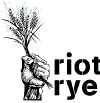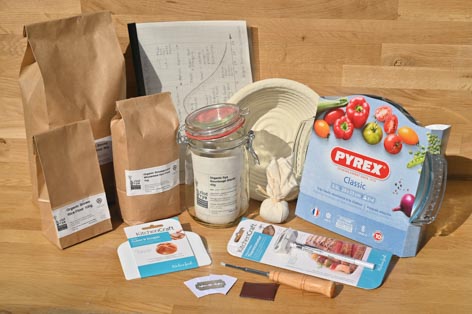The Common Loaf
The Common Loaf is a movement to empower Ireland to bake real bread.
It is a simple sourdough recipe and method which has been specifically developed for the home baker and for those who have little knowledge or experience in baking. The vision for this movement is that the knowledge of how to bake, nourish and share bread will be returned to the people and once again become part of common knowledge.
Bread is a natural food.
We believe that for too many years Ireland has been unnecessarily dependent upon the industrial baking and chemical industries for its bread. Many people do not have access to bread made without bicarbonate of soda, flour improvers, preservatives or other unnecessary additives. The knowledge of how to naturally turn grain into bread has been lost.
The Common Loaf provides an opportunity to give.
The third loaf should be baked for and gifted to another person. This process of making and baking for another will improve your baking skills and nourish others.
How to make it videos
Recipes
This starter takes one week to develop and then will last in perpetuity.
You will need:
- Container 1ltr with lid (a kilner jar is a perfect shape, however, do not lock the jar as carbon dioxide is produced during fermentation and needs to escape. If the container you choose is too wide, during the initial stages the starter may be liable to spread too thinly and inhibit fermentation)
- Scales (digital preferably)
- 325g Organic Wholemeal Rye Flour
- 325g Water
Day 1
- Weigh 25g Organic Wholemeal Rye Flour
- 25g Water
In your container, mix the flour and water together so that there are no dry bits, cover with the lid and leave in warm place (21C-25C), a warm part of your kitchen should be fine or your hot press.
The wild yeasts and bacteria on the flour will then begin to ferment the flour and after a couple of days you should notice a slight sour smell and taste and also some air holes.
Day 2
- Leave
Day 3
You are now going to refresh your starter by adding more flour and water to your juvenile starter. As the fermentation process has begun, this addition will ferment more quickly.
- Add 50g Organic Wholemeal Rye Flour
- 50g Water
Mix the flour and water together so that there are no dry bits, cover with lid. Leave in warm place (21C-25C).
Day 4
As you build up the beneficial bacteria and wild yeasts, you do so by keeping 1/3 starter and refreshing it with 1/3 flour and 1/3 water. To prevent from being over-run with and having too much excess starter you discard some.
- Compost 100g of starter keeping 50g
- Add 50g Organic Wholemeal Rye Flour
- Add 50g Water
- Mix the flour and water together so that there are no dry bits, cover with lid. Leave in warm place (21C-25C).
Day 5
- Compost 100g of starter keeping 50g
- Add 50g Organic Wholemeal Rye Flour
- Add 50g Water
- Mix the flour and water together so that there are no dry bits, cover with lid.
- Leave in warm place (21C-25C)
Day 6
You are now going to build up enough starter so that you can make your bread tomorrow.
- Add 150g Organic Wholemeal Flour
- Add 150g Water
- Mix the flour and water together so that there are no dry bits, cover with lid
- Leave in warm place (21C-25C).
Day 7
- Make the ‘Common Loaf’.
- The recipe for the ‘Common Loaf’ uses 300g starter.
Whenever you make the ‘Common Loaf’, you will use 300g of starter and the remaining 150g should be stored in your fridge for your next bake.
Next time
- 12hrs before bake
- Repeat from Day 6
Ingredients:
- 300g organic wholemeal rye starter
- 720g organic white strong flour
- 480g water
- 15g sea salt
Method:
- In a mixing bowl bring together the sourdough starter, flour and water until all ingredients are wet and there are no large lumps. Cover bowl with a tea towel and leave for 30 mins. (This process is called autolyse and allows the gluten, wild yeast and bacteria to develop.)
- After 30 mins: add salt, this will regulate the fermentation and fix the gluten. Return the dough to a clean lightly oiled mixing bowl with the smooth side up.
- After 30 mins: stretch and fold the dough like a letter to develop the gluten and trap air. Return the dough to a clean lightly oiled mixing bowl with the smooth side up.
- After 30 mins: stretch and fold the dough like a letter to develop the gluten and trap air. Return the dough to a clean lightly oiled mixing bowl with the smooth side up.
- After 30 mins: stretch and fold the dough like a letter to develop the gluten and trap air. Return the dough to a clean lightly oiled mixing bowl with the smooth side up.
- After 30 mins: stretch and fold the dough like a letter to develop the gluten and trap air. Return the dough to a clean lightly oiled mixing bowl with the smooth side up.
- After 30 mins: divide the dough into 2 pieces, form into balls, place to one side to rest as you flour a cloth lined pyrex dish or proofing basket. Place the dough smooth side down in the floured cloth lined bowl of pyrex dish Pre-heat the oven to 250C.
- If you have a 2nd pyrex dish you can repeat the shaping of the dough and placing in a the dish to prove. (If not you can form your dough into a ball and place the dough smooth side down in the floured cloth lined bowl, cover and place in the fridge until your pyrex dish is available. You can keep your dough in the fridge for up to 24 hrs before baking.)
- After 90-120 mins: the dough should be ready to bake. Turn over pyrex dish so that it falls into the lid, remove cloth, slash dough about 1/3 of a cm. Replace pyrex bowl back over dough. Place in hot oven at 250C.
- After 30 mins: check if there is a good colour on the crust, remove pyrex bowl (on top) and continue to bake for 10 more mins until good hard crust all round.
- When your loaf is baked, remove from the dish and let cool on a rack.
Enjoy The Common Loaf!
Baking Kit
This baking kit will set you up with everything you need to bake The Common Loaf and get you started on your sourdough journey!

